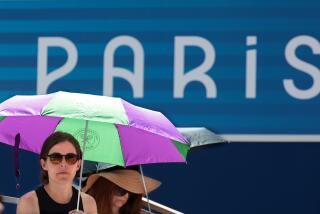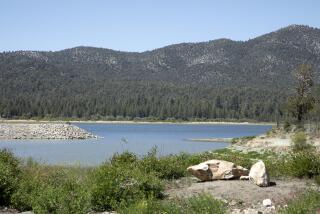Test Competitions Show Nagano Still Needs Some Fine-Tuning
- Share via
SHIGA KOGEN, Japan — Jure Kosir came off his final run down Mount Higashidate all smiles. Next year the race here will be for Olympic gold, and Kosir wouldn’t have it any other way.
“This course has everything an Olympic giant slalom course should have,” said Kosir, a World Cup veteran from Slovenia. “You can compare it to the best courses in Europe or the United States.”
Not all reviews of Nagano’s preparations for next year’s Winter Games are so glowing.
The past two months have been a rehearsal for Nagano, with World Cup competitions at its Olympic venues for everything from skiing to bobsledding to luge.
But with less than a year to go before the games, which begin Feb. 7, many venues are being criticized for something: wind exposure, lack of spectator access or failure to meet the high expectations of international sports groups.
Nagano organizers found themselves at odds again this week with IOC vice president and International Ski Federation (FIS) head Marc Hodler, who was in the city to inspect the Olympic facilities.
At a news conference wrapping up his tour, Hodler made yet another call Tuesday for changes in the men’s downhill course. “We would be pleased if changes were made,” he said.
The problem with the downhill has been the start--from the start.
Nagano organizers have refused to make the men’s downhill course longer by putting the starting gate higher up the mountain, a change the FIS says is essential if the event is to be of Olympic quality. Local environmental groups strongly oppose the idea.
“We have no intention of raising the starting point,” said Makoto Kobayashi, the director general of the Nagano Organizing Committee.
The starting gate problem is just one on a long list.
Nagano organizers also have been criticized by international sports groups over the ice hockey and figure skating venues, which are expected to be big draws but are to be held in smaller-than-hoped-for arenas.
Organizers say they have increased the original seating plans, and expect no particular shortage.
Another problem is the clash between police trying to enforce Japan’s strict anti-gun laws and the International Modern Pentathlon and Biathlon Union.
The Olympic competition is to be held on the sparsely populated outskirts of Nozawa Onsen, a scenic hot springs village about an hour’s train ride from Nagano City.
But police are so nervous about the use of bullets that they ordered two ski lifts nearby to close down during a World Cup meet this month, a costly precaution for a village that relies heavily on income from skiing tourists.
Villagers say it was unnecessary--the only way a bullet could hit the ski areas would be if a shooter aimed away from the targets.
The biggest headache for Nagano, however, might well be something the organizers will have no control over--the weather.
Nagano is the first Asian city to play host to the Winter Games since Sapporo, Japan, in 1972. Nagano also is the most southern host ever, at roughly the same latitude as San Francisco. Summer temperatures in Nagano can reach 95 degrees.
Nagano’s venues also are prone to some wild swings in temperature and snow conditions--both of which have been a major problem:
--Rain caused several delays during a women’s World Cup downhill last month. A year ago, two men’s World Cup races were canceled due to heavy snowfall.
--Heavy snowfall forced the cancellation of a World Cup ski jumping event in January.
--During a World Cup bobsled event, the afternoon sun melted ice on portions of the refrigerated track, prompting coaches to complain that Olympic competitions will be ruined unless the runs are early in the morning.
Nagano organizers have been reluctant to accept such changes, fearing friction with broadcasters who are paying record fees and are less concerned with the quality of the competition than with the size of the viewing audiences.
Calgary in 1988 had a similar problem, which it tried to solve by draping curtains over the affected sections to keep them in the shade.
It’s not the first time weather has been a problem at major winter events in Japan.
Four years ago, snow, wind and rain at the World Alpine Ski Championships forced the cancellation of all racing on four days and wiped out the men’s super-giant slalom completely. However, those events were held at Shizukuishi, about 90 miles northeast of Nagano in a different mountain range.
For the athletes, there is little to do but hope for the best.
“It’s a really challenging hill, it’s not easy,” Canadian Alpine skier Thomas Grandi said at last weekend’s World Cup events. “The snow can be a concern, but hopefully in February it will be cooler.”
More to Read
Go beyond the scoreboard
Get the latest on L.A.'s teams in the daily Sports Report newsletter.
You may occasionally receive promotional content from the Los Angeles Times.






